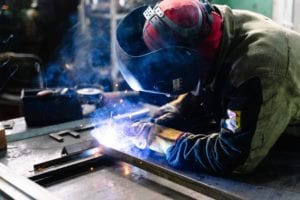Today, welding processes have evolved to meet the needs of varied industries. MIG welding and flux-cored arc welding (FCAW) both use a wire-feed process. MIG welding is ideal for plate metals and easy to learn. FCAW does not require the use of shielding gas. Like MIG welding, FCAW is easy to pick up and can create clean welds on aluminum, steel and stainless that are as thin as 26-gauge.
TIG welding produces the weld by using a non-consumable tungsten electrode. It also often requires the use of shielding gas and filler metal. Alloy steel, nonferrous metals, and stainless steel are often involved in TIG welding projects.
Stick welding is popular for use in home shops. The welding stick and the metal is the location of an electric current that flows between them. Most joints and alloys can be welded using stick welding. It’s also versatile enough to be used in drafty areas, as well as indoors and out.

How Is Portable Welding Different?
Portable welding is designed to remove the awkwardness of being in an uncomfortable position. Instead of being fatigued and/or compromised by this possibility, a portable welding machine allows the operator to concentrate on creating a weld that is both safe and high in quality.
A portable welding carriage — which is sometimes referred to as semi-automation — moved the torch along the project in a controlled way. This frees up the welder and makes the job easier by reducing the exposure to fumes and heat. The portable welding carriage might rely on a magnet or follow a track.
There are also trackless models. In this case, an operator who is experienced in portable welding systems is needed. Still, other weld carriages use guidance wheels to ensure that the machine is aligned correctly with the weld. Factors that should be considered when determining how much is a portable welding machine include the weld’s length, its position and its type.
To learn more about our portable welding services, please contact us today!
